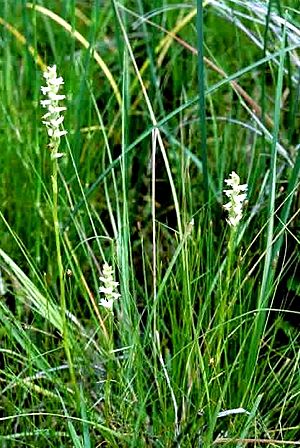Reclusive lady's tresses facts for kids
Quick facts for kids Reclusive lady's tresses |
|
|---|---|
 |
|
| Conservation status | |
| Scientific classification | |
| Genus: |
Spiranthes
|
| Species: |
delitescens
|
The Spiranthes delitescens is a very rare type of orchid. People call it the reclusive lady's tresses, Canelo Hills lady's tresses, or Madrean lady's tresses. It only grows in Arizona in the United States, and there are only four known places where it lives. This orchid is in danger because its home is being lost or damaged. It is officially listed as an endangered species in the United States.
Contents
About This Special Orchid
What It Looks Like and When It Was Found
This orchid was first found in 1968. Scientists officially named it a new species in 1990. It grows a straight stem that can be up to 50 centimeters (about 20 inches) tall. Its thin leaves grow around the bottom part of the stem and can be up to 18 centimeters (about 7 inches) long.
The flowers grow in a spiral shape at the top of the stem. This part of the stem has tiny, sticky hairs. Each flower has white, cream, or yellowish petals that curve. They are almost one centimeter (less than half an inch) long. These orchids usually bloom in July and August.
How Orchids Grow
Like other orchids, the reclusive lady's tresses needs special help to grow. It depends on tiny living things called mycorrhizae. These are types of fungi that live in the soil. They help the orchid's seeds sprout and give the plant important food.
Where the Orchid Lives
Cienegas: A Wet Home in a Dry Land
This orchid grows in places called cienegas. A cienega is a special kind of wetland habitat. It's a wet area in a part of the southwestern United States that is usually very dry. These orchids grow at an elevation of about 1525 meters (5000 feet) above sea level.
Other plants that grow in these wet areas include different kinds of grasses, sedges, spikerushes, cat-tails, and horse-tails. Cienegas stay wet because of springs that flow there during certain times of the year.
Two of the cienegas where this orchid lives are the O'Donnell and Turkey Creek Cienegas. They are about 40 kilometers (25 miles) southeast of Tucson, Arizona. The O'Donnell Cienega is owned by The Nature Conservancy, a group that protects nature. A person lives there to help take care of the site. The other two places where the orchid is found are Babocomari Cienega and Sheehy Spring, which are also nearby. It's possible that this orchid also grows south of the border in Sonora, Mexico.
Why It's Hard to Count Them
It is difficult to know exactly how many of these orchids there are. This is because they spend most of their time in a resting state. They stay hidden in the thick plants around them. When they are resting, they don't have many parts above ground that are easy to see.
Dangers to the Orchid
Losing Its Home
The biggest danger to the reclusive lady's tresses is that its home is being lost or damaged. This happens partly because of non-native plants that move into the area. These new plants are not from around there and can take over. Also, native plants that are supposed to be there can sometimes grow too much.
The worst invasive plant is called Johnson grass (Sorghum halepense). The orchid naturally grows near different kinds of horse-tail plants and other marsh plants. But if these plants grow too thick, the orchid cannot push through them. Horse-tails can also outcompete the orchid, meaning they take too much of the light and resources.
Other Threats
It is also thought that stopping natural fires might be a problem. Fires naturally help thin out competing plants. Grazing by cattle and other farm animals is another danger. However, grazing has been stopped in the most sensitive cienega areas.
Changes in how water flows in these wetlands are also a threat. The habitat is still recovering from when people tried to drain the land over a hundred years ago. Pumping groundwater (water from under the ground) also reduces the amount of water available for the plants.
What Its Name Means
The specific name delitescens comes from a Latin word, delitescere. This word means "to hide," "to withdraw," or "to take refuge." This name fits the orchid well because it often stays hidden!


